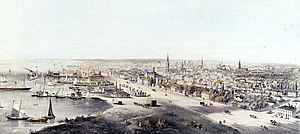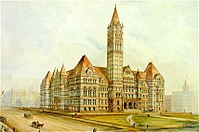
| History of Toronto | ||||||||||||||||
|---|---|---|---|---|---|---|---|---|---|---|---|---|---|---|---|---|
 | ||||||||||||||||
| History | ||||||||||||||||
|
||||||||||||||||
| Events | ||||||||||||||||
|
||||||||||||||||
| Other | ||||||||||||||||
|
| ||||||||||||||||
Toronto was founded as the Town of York and capital of Upper Canada in 1793 after the Mississaugas sold the land to the British in the Toronto Purchase.[1] For over 12,000 years, Indigenous People have lived in the Toronto area. The ancestors of the Huron-Wendat were the first known groups to establish agricultural villages in the area about 1,600 years ago.[2]
In the 17th century, the Toronto Carrying-Place Trail along the Humber River became a strategic site for controlling the fur trade farther north. The Seneca people established a village of about 2,000 people known as Teiaiagon along the trail.[3] The French set up trading posts in the area, including Fort Rouillé in 1751, which they abandoned as the British conquered French North America in the Seven Years' War.
In the 1790s the British began to settle Toronto and built the garrison which became Fort York at the entrance to Toronto Harbour. The Americans attacked the village and garrison during the War of 1812. In the decades after the war, tensions between the colony's conservative elite, the Family Compact and the democratic Reformers grew and culminated in the Rebellions of 1837-1838.[4]
After the failed rebellion, the Orange Order, a conservative Protestant fraternal organization, became the dominant power in local politics in a city intensely dedicated to Britishness.[5] However, the city was not exclusively British. Many Irish Catholics settled in the city following the Great Irish Famine. The city was also a terminus of the Underground Railroad. Thousands of Black Americans who escaped slavery settled in Toronto before the American Civil War.[6]
In the second half of the 19th century, Toronto grew into an important regional centre, linked to the rest of Ontario by a growing railway network and American and British markets by its port.[7] By 1914, the city's financial sector, profiting from a mining boom in northern Ontario, was competing nationally with Montreal, while American corporations were increasingly choosing Toronto for branch offices.[8]
World War I and World War II tremendously impacted the city, with tens of thousands of residents volunteering to fight and participating locally in a "total war" effort.[9]
After World War II, another major influx of immigrants came to the region. The Province of Ontario formed a regional government, Metropolitan Toronto, encompassing Toronto and its suburbs in 1954. The Governments invested heavily in infrastructure facilitating a boom in population and industry. In the second half of the 20th century, Toronto surpassed Montreal as Canada's largest city and became the economic capital of Canada and one of the most multicultural cities in the world. In 1998, the Province of Ontario amalgamated the metropolitan governments and its suburbs into one unified municipality.
- ^ Careless, J. M. S. (1984). Toronto to 1918 : An Illustrated History. Toronto: J. Lorimer & Co. p. 17. ISBN 978-0-88862-664-6.
- ^ Williamson, Ron; Lesage, Louis (2021). Bolduc, Denise; Gordon-Corbiere, Mnawaate; Tabobondung, Rebeka; Wright-McLeod, Brian (eds.). Indigenous Toronto: Stories That Carry This Place (First ed.). Toronto, ON: Coach House Books. pp. 46–47. ISBN 978-1-55245-4152.
{{cite book}}: CS1 maint: multiple names: authors list (link) - ^ Levine 2014, p. 12-13.
- ^ Levine 2014, pp. 45–58.
- ^ Smyth 2015, pp. 20–21.
- ^ Shadd, Adrienne L.; Cooper, Afua; Smards Frost, Karolyn (2011). The Underground Railroad: Next Stop, Toronto!. Toronto [Ont.]: Natural Heritage Books. pp. 2–3. ISBN 978-1554884292.
- ^ Careless, J. M. S. (1984). Toronto to 1918 : An Illustrated History. Toronto: J. Lorimer & Co. p. 73. ISBN 978-0-88862-664-6.
- ^ Careless, J. M. S. (1984). Toronto to 1918 : An Illustrated History. Toronto: J. Lorimer & Co. pp. 149–152. ISBN 978-0-88862-664-6.
- ^ Glassford, Sarah. "Volunteering in the First and Second World War". Wartime Canada. Retrieved November 29, 2022.
